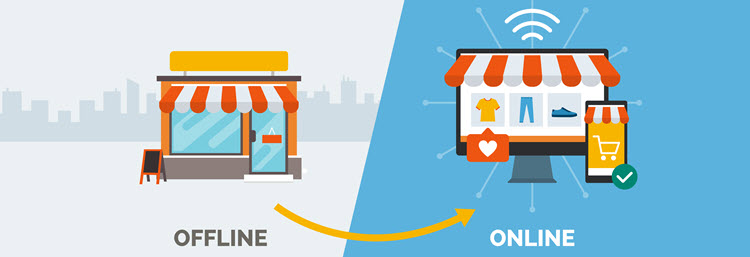The first businesses that embraced and successfully implemented omnichannel marketing raised customers’ expectations and set new customer service standards in their respective niches. As a result, many companies are considering following in the footsteps of omnichannel pioneers and developing their own successful omnichannel strategies.
The world’s largest companies are connecting marketing channels and optimizing touchpoints so that they become a part of a frictionless omnichannel experience. Should all businesses take the same path?
Get acquainted with omnichannel benefits and discover how adopting an omnichannel strategy can support and fulfill a business’s vision and goals.
7 Omnichannel Benefits
The benefits of adopting an omnichannel approach are most visible in the following areas.
1. Increased Sales

Businesses implementing an omnichannel strategy experience a boost in sales. This growth can be attributed to the following:
- Customers shop however they prefer.
- Customers do not lose progress or experience friction when switching channels.
- Merchants use personalization to target customers with relevant offers via their preferred marketing channels.
- Every step of the customer journey is designed with the customer’s experience and best interests in mind.
- Merchants give customers access to all the information impacting their purchase decisions (product descriptions, return policies, exclusive offers).
2. Reaching Broad and Diverse Audiences

The more marketing channels a company uses, the more people it can reach with its campaigns. However, any brand’s prospective customers are not a uniform group and differ in the following:
- Preferred marketing channels.
- Favorite social media platforms and reasons why they use them.
- Time spent online.
- Part of the day they dedicate to screen time.
- Likelihood they will follow trends, etc.
Understanding and leveraging these differences allows the creation of individual and unique buyer personas a business then targets as needed.
3. Connecting Online and Offline Experiences

The essence of the omnichannel experience is to allow customers to choose how they want to achieve their goals. For this to work, it is crucial to ensure that across all channels customers are given:
- Consistent information.
- A uniform customer experience.
- The ability to switch from online to offline and vice versa at any point.
Offline and online are not only connected by data and similar customer experiences. A typical example of connecting the physical and digital in omnichannel are digital coupons and interactive mobile applications designed to be used in physical locations.
4. Better Operational Efficiency

An omnichannel strategy entails connecting all marketing channels, business departments, and customer touchpoints into a single unified ecosystem. This holistic approach results in improvements in the following areas:
- Inventory management. Merchants supervise their inventory in all retail and storage locations in real-time and via a single system. This allows them to improve restock planning, anticipate customer demand and shopping trends, and ensure better overall inventory management.
- Order fulfillment. Merchants have real-time access to order information, while customers can track their orders. Giving all participating parties access to order fulfillment information ensures orders are completed in the shortest amount of time, reduces the chance of friendly fraud, and enhances shopper safety.
- Internal communication. In omnichannel, information is collected and stored in a single database that all departments can access. This database gives all employees a single and true source of information, making communication easy, efficient, and accurate.
- External communication. Customers can choose from numerous options when they wish to communicate with a brand. While this is true for multi-channel as well, the benefit of omnichannel lies in channel connectivity. If a customer’s journey is interrupted for whatever reason, then can move to a different communication method to continue where they left off. Instead of losing a customer, the business retains them.
- Human resource management. Omnichannel treats the customer experience as a system consisting of dozens of interconnected pieces. The same applies to the company. Employees achieve optimal performance because they understand how the ecosystem they are a part of works. In the case of human resource reallocation, employees require less additional training because they continue to use the information system they are used to.
5. Improved Data Collection and Analysis

In omnichannel, every interaction between a customer and a brand is used to enhance shopping experiences on a micro and macro level.
On a micro level, collated customer data helps to provide a more personalized experience. Every customer is served content that caters to their particular interests.
On a macro level, data collection and analysis are used to gain insights into how the customer journey can be improved as a whole. An example would be receiving a customer support ticket that points out a malfunctioning touchpoint, or a request for information that was not clearly stated in another touchpoint, etc.
6. Greater Customer Satisfaction

Customers do not consider omnichannel an option but a requirement.
To ensure customer satisfaction, brands must provide customers with different interconnected marketing channels they can use to communicate with the brand. Sticking with a single or multi-channel approach causes prospective customers to consider and eventually switch to competitors.
According to Harvard Business Review:
- 73% of customers prefer shopping through multiple channels.
- 80% of customers prefer omnichannel strategies over single- or multi-channel due to the seamless shopping experience they provide.
Given these numbers, it is little surprise that 90% of retail leaders agree that adopting an omnichannel strategy is crucial to a business’s success.
7. Increased Customer Lifetime Value (CLV)

Omnichannel customers purchase more frequently and increase purchase value over time, according to Omnisend. In fact, omnichannel customers have a 30% larger customer lifetime value than single-channel customers.
The loyalty of omnichannel customers can be attributed to the following:
- Omnichannel businesses are customer-centric and focus on providing outstanding customer service.
- The seamlessness and convenience of omnichannel shopping invokes positive feelings in customers, turning them into repeat customers.
- Omnichannel customer journeys cater to customers’ needs and expectations.
- Personalization, a marketing strategy associated with omnichannel marketing, makes customers feel listened to and cared for.
- Omnichannel businesses often feature a well-designed loyalty program.
Conclusion
Omnichannel is no longer an option, it is a necessity for any business wishing to survive and thrive.
Omnichannel implementation requirements may seem daunting to business owners, making them reluctant to make the switch. However, the benefits mentioned above serve as proof that omnichannel is here to stay and that businesses will be moving in that direction in the future.
